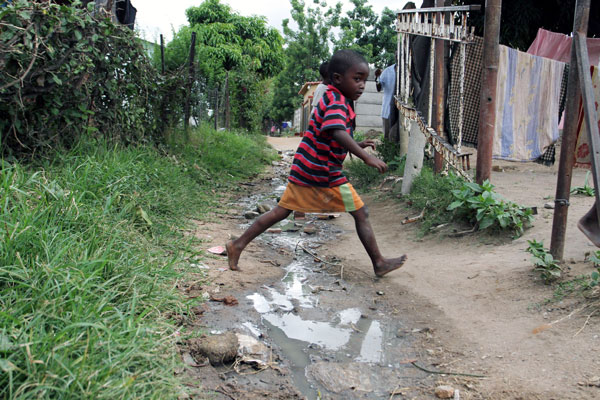
Water and air pollution are some of the major problems faced by many cities across the world. These challanges often lead to health-related and environmental issues. But with proper treatment of water, infrastructure and waste management, it is possible to reduce such kinds of pollution.
Social commentary with Moses Mugugunyeki

Somewhere in Manyame Park, Chitungwiza, a group of children, oblivious of the dangers, play near a pool of sewage and a stone’s throw away, there is a burning rubbish heap where acrid smoke is scorching their eyes and throats.
To them, it’s pleasure as usual, but they are part of millions of children around the globe who are exposed to toxic air on a daily basis.
Children have rights to be supported in their health and wellbeing. These rights are articulated in the United Nations Convention on the Rights of the Child (UNCRC), to which Zimbabwe is a signatory.
While the articles in the UNCRC are not enforceable in their own right in relation to specific services, Zimbabwe’s ratification of the Convention committed the government to realise them through legislation such as the Hazardous Waste Management Regulations Statutory Instrument (SI) 10 of 2007 which regulates waste collection and management by local authorities, as well as the Air Pollution Control Regulations SI 72 of 2009 which provides for the prevention, control and abatement of air pollution to ensure clean and healthy ambient air.
Although armed with these pieces of legislation, the government has done little to address the issue of unsanitary and polluted environments, thus violating children’s rights as enshrined in the Convention.
Residents in Chitungwiza said there were no systems in place to deal with air pollution and waste management.
- Chamisa under fire over US$120K donation
- Mavhunga puts DeMbare into Chibuku quarterfinals
- Pension funds bet on Cabora Bassa oilfields
- Councils defy govt fire tender directive
Keep Reading
“The burst sewers and pungent smell emanating from the sludge and the burning garbage are now part of life; we are now used to that. Our children grew up seeing the sewage flowing and as of the acrid smoke that you are talking about, it has become part of our everyday living,” said Tendai Dube, a resident of St Mary’s.
In its report titled Inheriting a Sustainable World: Atlas on Children’s Health and the Environment released last year, the World Health Organisation (WHO) said globally about 25% of deaths of children younger than five were caused by unhealthy or polluted environments.
The report added that unsanitary and polluted environments can lead to fatal cases of diarrhoea, malaria and pneumonia, which kill 1,7 million children a year.
The UN agency found that the most common causes were preventable.
Most residents in Chitungwiza dump rubbish in open spaces which they burn, resulting in pollution. But other pollution sources, including construction dust and cooking fires fuelled by wood or paraffin, continue unabated in the town, which is home to nearly half a million people.
“We hardly have running water in this area. Our taps are always dry and water is supplied twice a week. When supplies are restored, the sewer is overwhelmed and in most cases it bursts,” said Dube.
More than 90% of the world’s population is thought to breathe toxic air, thereby violating quality guidelines set by the world health board.
“A polluted environment is a deadly one, particularly for young children,” said WHO in the report. “Their developing organs and immune systems and smaller bodies and airways, make them especially vulnerable to dirty air and water.”
Health experts say children face much higher health risks from air pollution than adults. They added that children breathe twice as quickly, taking in more air in relation to their body weight, while their brains and immune systems are still developing and vulnerable.
Local health expert Johannes Marisa acknowledged that health risks from air pollution were taking a toll on children’s health.
“It’s true. We are having these health problems, especially in cases where children are exposed to air and water pollution, as well as sewage,” he said.
Chitungwiza’s health delivery system is strained, considering that the town has four clinics that serve a population of 400 000 people.
Dube said the problem could be prevented by access to clean water, sanitation and hygiene in health facilities, as well as reducing air pollution.
Like any other overcrowded and poorly serviced settlement, Chitungwiza has over the years been one of the hardest hit by typhoid and various respiratory diseases.
The town’s public relations officer Lovemore Meya acknowledged that the local authority was facing challenges in waste management.
“Well, at the moment we are having a difficult time when it comes to solid waste management. Despite the aged fleet that we use to manage solid waste, the current fuel shortages have complicated service delivery since almost all our vehicles are without fuel,” Meya said.
“As you are aware that this is a national crisis [fuel shortages], instead of collecting refuse, say, once per week, we are now forced to go up to two weeks without doing so.
“It is our wish to manage solid waste and ideally we would want to collect refuse on every property, but with this situation, it is difficult. We would like also to apologise to our ratepayers and residents for the changes in our collection schedule due to fuel shortages.”
WHO said investing in the removal of environmental risks to health, such as improving water quality or using cleaner fuels, would result in massive health benefits.
The world health body said top causes were respiratory infections, with 570 000 deaths in children younger than five linked to indoor and outdoor air pollution and second-hand smoke, and diarrhoea, with 361 000 deaths in children under five linked to poor access to clean water, sanitation and hygiene.











